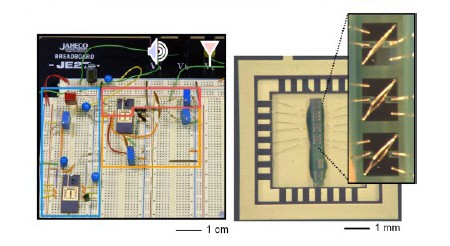
The first practical transistor radio made entirely of carbon-nanotube based electronics has been unveiled by researchers in the US. Unlike previous nanotube radios, which produced very weak signals that needed further amplification, the team were able to listen to a local broadcast on headphones connected directly to a nanotube transistor.
To make the radio, John Rogers of the University of Illinois and colleagues worked out a way to align thousands of the nanometre-diameter tubes in sheets in order to create electronic devices that can handle sufficiently large currents to be of practical use (pnas.0709734105). The team claim that their technique is reliable and compatible with commercial electronics fabrication processes.
Carbon nanotubes can be thought of as single sheets of graphite that have been rolled up into a tiny tubes. They are also semiconductors and have been used to create different electronic devices including tiny transistors and even a nanometre-size radio receiver. Because of their tiny size and high electrical and thermal conductivity, they could in principle be used to create very small and extremely fast electronic circuits — however, it is still not clear how nanotubes could be used in practical devices.
Chemical vapour deposition
The Rogers team took up this challenge by coming up with a way to create horizontally aligned arrays of individual nanotubes in a single-step growth process across the entire surface of a quartz wafer. The growth process relies on chemical vapour deposition in which a gas like methane or ethanol is introduced into a furnace containing the wafer with some metal catalyst nanoparticles on its surface. Orientation dependent interactions between the growing tubes and the quartz lattice lead to alignment along a particular crystallographic axis of the wafer.
The researchers then incorporated the nanotube sheets into RF transistors and circuits. The nanotubes were almost perfectly linear and almost perfectly aligned and parallel to each other, which allowed the team to make a large number of transistors. “Each device in such an approach incorporates thousands of tubes, such that the statistical averaging effects lead to good device-to-device uniformity in electrical properties,” said Rogers.
Since individual nanotubes in each transistor device operate in parallel and independently, the devices can produce large current outputs. This means that they can have high levels of gain and amplification in both the RF and audio frequency ranges.
More importantly, many devices can be produced at once and integrated into circuits. Such features were absent from nanoradios and other electronic devices that incorporated only single nanotubes.
Unique array geometry
“Ours is a technology that enables all of the components (resonant antennas, RF amplifiers and mixers, and audio amplifiers) to be formed with nanotube devices,” added Rogers. “These capabilities derive from their unique array geometry.”
The team are now building medium-scale circuits containing up to 100 transistors and are also implementing advanced designs to improve the RF response. “Finally, we are working to advance certain aspects of the devices by using new materials for contacts to the tubes, and increasing the power efficiency of the systems.”




